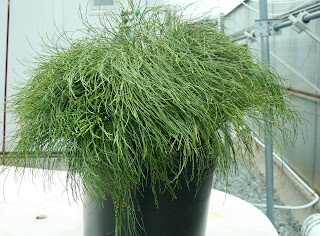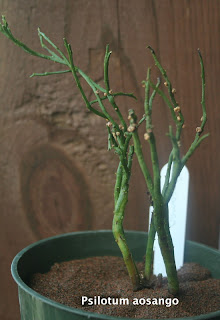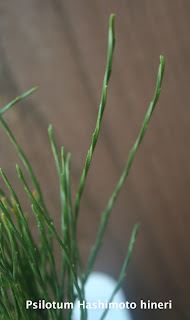Psilotum (MATSUBARAN)
Fallow Me on Instagram @RootWunder
Psilotum are primitive ferns that have been unchanged for hundreds of years. Two species nudum and complanatum. In Japan they have cultivated many other forms (species?) from the Edo Period (1603-1867) until now. There are short stubby forms (species?) and there are some that have clumpy tips. Some that are variegated and others that are straight growing. At one time there was said to be more them 200 forms (species?) in cultivation. I like to grow them like bonsai trees. They like to have good drainage and bright light. Contact me if you are interested in starting your collection...
Psilotum complanatum
Photos of Psilotum complanatum growing in the wild in Malaysia.
Photo by : Huang Shih Chieh



Photo by Tom Bollinger to see more photos visit this link Polylepis Flickr
P. complanatum that grows in Hawaii does not grow as long and is much slower to mature and produce new stems.


Psilotum intermedium
This is a Psilotum cross between P. nudum and P. complanatum. From Hawaii: Propagation from plants grown at the Matthei Botanical Garden at the University of Michigan brought there by the late Dr. Warren Herb Wagner who described the hybrid.


The stems of this cultivar are flat/pendulum like complanatum and upright like nudum. This make a nice specimen plant... The sporangia are formed on the tips of the stems.
Psilotum nudum dwarf "Florida International University" Chad Husby
Japanese Psilotum
In Japan growers have collected and cultivated Psilotum pre edo period (1603-1867) and until now. Many of the forms where collected in the wild and new forms where created from them. Over the years many where lost but there are still a few that remain. I have dedicated this sight to the introduction and the preservation of these rare forms that could be new/old species.
In 1992 there was a pink book published on the topic of growing psilotum. Some of the info I have gathered has been from the help of interpreting the righting in this book threw the help of a friend. Some of the images will have Page # referring to the page in this book.
Psilotum Yoji Bunryu
Originally collected or came from Waka Yama Japan. When page 42 was being interpreted it mentioned that this was a form of Bunryuzan. See Bunryuzan


Subscribe to:
Comments (Atom)









































